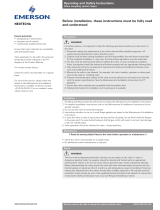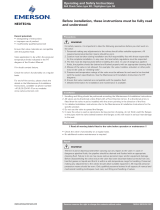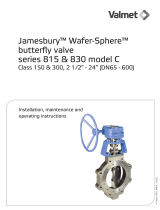Page is loading ...

KEYSTONE OPTISEAL F14/16 - 15/17 AND BREWSEAL BUTTERFLY VALVES
INSTALLATION AND MAINTENANCE INSTRUCTIONS
1 STORAGE AND HANDLING
1.1 Storage
When valves are to be stored for some time
(2months or more) before being fitted, storage
should be in the original delivery crates
orcases.
1.1.1 Storage conditions
The valves should be stored off the ground
inaclean, dry indoor area.
Protect the valve from temperature and
humidity extremes, and exposure to excessive
dust, moisture, vibration, deformations,
sunlight and ozone.
Recommendations
1. Temperature: storage temperature below
25°C, above 0°C preferable below 15°C.
2. Humidity: storage conditions should be such
that condensation does not occur, store in
a dry environment. Maximal 50% relative
humidity.
3. Light: valve rubbers should be protected
from light, in particular direct sunlight or
strong artificial light with high ultra violet.
Intended valve use
The valve is intended to be used only in
applications within the pressure/temperature
limits indicated in the P/T diagram of
theproduct manual.
When the valve is used in an end-of-line function,
PED Cat-I applications are allowed only. For
other categories, please contact thefactory.
VCIOM-00747-EN 15/05
IMPORTANT
Before valves are being installed or used
thefollowing actions are recommended.
1. Valves/parts have to be inspected and
thoroughly cleaned if required.
2. Rubber parts need to be greased with silicone
grease if not present anymore.
3. All surfaces in contact with seats have to be
thoroughly cleaned and greased with silicone
grease if stored for more than 5 months.
1.2 Handling
To prevent damage during handling,
thevalves should be lifted by hand or using
appropriate lifting equipment. The valves
should be protected from external events e.g.
(bumps,hitting and vibration) during transport.
Any flange protection caps need to be removed
before the valve is mounted in the pipeline.
Lift the valve with great care from the transport
package (crate, pallet). While handling or
installing the valve, ensure that no damage
occurs to the valve, the pneumatic/electrical/-
hydraulic actuator or other instrumentation.
2 SPARE PARTS
Only original Keystone spare parts are
allowed to be used. Safe operation can not be
guaranteed if third party spare parts are used.
4. Ozone: storage rooms should not
contain any equipment generating ozone.
E.g.lamps, electric motors.
Before installation these instructions must be fully read and understood
www.valves.emerson.com © 2017 Emerson. All rights reserved.

2
KEYSTONE OPTISEAL F14/16 - 15/17 AND BREWSEAL BUTTERFLY VALVES
INSTALLATION AND MAINTENANCE INSTRUCTIONS
3 INSTALLATION
WARNING!
For safety reasons, it is important to take the
following precautions before you start work on
thevalve:
1. Personnel making any adjustments to
thevalves should utilize suitable equipment.
All required personal protection means
shouldbe worn.
2. The line must be depressurized before
installing the valve.
3. Installation and handling of valves should be
done only by personnel that is trained in all
aspects of manual and mechanical handling
techniques.
4.
Misuse of the valve is not allowed.
Forexample: the valve, handles, actuators or
other parts may not be used as ‘climbing tools’.
5. Ensure that valve pressure/temperature
limitations marked on the identification tag
are within the service conditions. The trim
number on the valve’s tagplate identifies
the valve materials. See Product Manual for
valve specific P/T diagram and trim number
definition.
6. Ensure that valve materials are compatible
with the pipeline fluid.
7. For DVGW-Gas approved lugged valves,
through threaded rods must be used instead
of flange bolts.
YY
D max./min.
Q
3.1 Visual valve inspection
1. Confirm that the materials of construction
listed on the valve nameplate are
appropriate for the service intended and
areas specified.
2. Tag/name plate identification
Manufacturer: Keystone
Fig.: e.g. OptiSeal 14-112
JOB: Job number
Nominal size: DN
M.P.W.P.: maximum permissible
working pressure
Flange compatibility: e.g. PN 10/16
Temperature: e.g. -40/120°C
Body: e.g. GJL 250.
3.2 Flange and pipe compatibility
Check matching of flange drilling pattern
ofvalve and pipe before assembly.
Flanges have to meet the following
requirements:
- The face inside diameter should be:
D min.: the valve Q-dimension + adequate
disc clearance.
D max.: the optimum inside diameter (ID)
is equal to the inside diameter of flange
standard EN 1092-1, table 8, type 11.
Forlarger than D max inside diameters or
other flange types please contact your local
Emerson Sales organization, as larger inside
diameters might result in reduced valve
functionality.
Do not use flange gaskets, these lead to
valvedamage!
3.3 Valve installation
The valves are bi-directional and may be
fitted in either direction relative to the flow.
The valvewill control flow equally in either
direction. Therecommended installation
position is shaft horizontal and the lower disc
edge opening down-stream. (Especially for
slurry service and media with a tendency for
sedimen tation). For optimum valve control and
smooth performance, it is recommended to
have a 10to 20 pipe diameters of straight run
inlet piping and 3 to 5 pipe diameters straight
outlet piping.
A valve is no crow-bar. Do not use the valve
to spread the flanges. Seat damage might be
theresult.
- If the flange (or pipe) is provided with a
raised face, the diameter of this shall be at
least 8 mm larger than the YY-dimension of
thevalve.
The use of the flange-gaskets is not allowed
since it might damage the valve.
The Keystone seat-face design eliminates
theneed for the gaskets.
Use flange bolting in agreement with
appropriate standard.

3
NOTES
• The valve can be installed in the pipe-line either with
or without the actuator mounted on top of the valve.
Make sure that you can turn the disc cautious so you
can feel a mismatch resulting from a disc touching
the adjacent piping.
• It is the responsibility of the valve user - and not the
valve manufacturer! - to ensure that the pipeline
system has been built professionally and the valve
has been properly installed.
• Adjacent piping must be positioned so that minimal
piping stresses are transmitted to the valve flanges
during or after installation.
• Handling and lifting of the valves during installation
MUST be performed following the same instructions
described in previous section ‘1.2 Handling’.
IMPORTANT
Mating flange faces should be in good condition
and free of dirt and/or inclusions. Both pipe
insides to be well cleaned.
3.3.1 Existing system (see sketch)
1. Check whether the flange distance
meets the valve face-to-face dimensions.
Spreadwith adequate tooling the flanges
foreasy insertion of the valve.
2. In case of a wafer valve, insert some flange
bolts in the pipe flanges, to help you bear
the valve after insertion.
3. Close the valve so far, that the disc edge is
at least 10 mm within the body.
4. Insert the valve between the flanges, center
the valve body and insert all flange bolts.
Tighten the flange-bolts hand tight.
5. Slowly open the valve completely.
(Thediscis in line with parallel flats or
keyway in stem head. Keyway points
towards discedge).
6. Maintain the valve flange alignment while
gradually removing the flange-spreaders
and tighten the flange-bolts hand tight.
7. Slowly close and open the valve to check
foradequate disc clearance.
8. Cross-tighten all bolting to the proper
torque. Do not over tighten.
KEYSTONE OPTISEAL F14/16 - 15/17 AND BREWSEAL BUTTERFLY VALVES
INSTALLATION AND MAINTENANCE INSTRUCTIONS
3.3.2 New system (see sketch)
1. With the disc in near-closed position center
each mating flange with the valve body.
Fixthebody with some flange-bolts and
tighten the bolts.
2. Use the flange-valve-flange assembly
forfit-up and centering to the pipe.
3. Tack-weld the flanges to the pipe.
4. Remove the bolting and remove the valve
from between the flanges.
IMPORTANT
Do not finish-weld the flanges to the pipe with
thevalve bolted between the flanges as this will
result in serious heat-damage to the seat.
5. Finish-weld the flanges to the pipe and
allow the flanges to cool completely.
6. Install the valve now according to the
procedure for installing in existing systems.
3.4 Valve verification
Check the operation of the valve by operating
it to ‘full open’ and ‘full close’. To verify the
valve operation, the disc position indicator
on the actuator or the handle should rotate
between the ‘full open’ and ‘full close’
indicators on theactuator or throttle plate.
Generallythevalve disc travels clockwise
toclose.

4
EXISTING SYSTEM NEW SYSTEM
1. Spread the flanges with the adequate tooling.
Insert some flange bolts to bear the valve.
1. Center a flange-valve-flange assembly
between the pipes.
2. Open the valve and remove the flange spreads. 2. Tack weld the flanges to the pipes.
3. Close the valve clockwise, return to open position
and cross-tighten all bolting.
3. Remove the valve and finish weld.
Installthevalve according to the procedure
inthe left column.
3.5 Sources of possible danger
This section contains some examples of
possible foreseen danger sources.
3.5.1 Mechanical
A. When manual operators are used, available
space should be checked in order to avoid
hands being clamped.
B. Mechanical sparks caused on impact of
valve and e.g. tooling, are a potential source
of ignition of surrounding atmosphere.
3.5.2 Electrical
If static charges or stray electrical currents
can initiate explosions, the valve should be
grounded to earth.
3.5.3 Thermal
A. Isolation should be used on valves with
application temperatures > +40°C and
<-20°C to prevent them from being touched
(to avoid burning).
B. If the valve is used in hot gas/fluid
applications that might give exothermic
reactions, precautions must be taken so
that the valve surface can not lead to danger
for people or the direct environment. In dust
and possible explosion zones, the operation
temperatures and ignition temperatures
fordust should be reviewed.
3.5.4 Operational
Closing a valve too fast may result in
waterhammer in the upstream part of
thepipeline. Waterhammer results in excessive
stresses in the valve and will cause severe
damage.
Waterhammer should be avoided in all
circumstances.
Due to differential pressure across the valve
disc, butterfly valves have the tendency to be
closed by the flow. Take care when unlatching
the valve operating mechanism.
KEYSTONE OPTISEAL F14/16 - 15/17 AND BREWSEAL BUTTERFLY VALVES
INSTALLATION AND MAINTENANCE INSTRUCTIONS

5
4 MAINTENANCE BUTTERFLY VALVES
OPTISEALFIG. 14/16 AND BREWSEAL
The Keystone butterfly valves OptiSeal Fig.
14/16 and BrewSeal are designed to require
aminimum of maintenance.
WARNING!
Depressurize and, if necessary in case of
dangerous fluids, drain the line and flush with
appropriate cleaning fluid before starting any
maintenance. Failure to do so may cause serious
personal injury and/or equipment damage.
Before disassembling the valve, ensure the valve
has been decontaminated correctly from any
harmful gasses or liquids and that it is within
asafe temperature range for handling.
Personnel making any adjustments to the valves
should utilize suitable equipment. All required
personal protection means should be worn.
We recommend that personnel should be trained
in all aspects of these instructions before carrying
out handling of any valve.
4.1 Routine maintenance
The Keystone OptiSeal Fig. 14/16 and BrewSeal
butterfly valves are designed to require
aminimum of maintenance.
Routine maintenance or lubrication is not
required, we recommend periodic (visual)
inspection to ensure satisfactory operation and
sealing to the environment.
4.2 Removing the valve from thepipesystem
1. Turn the disc to nearly closed position.
(Thedisc is in line with the parallel flats
inthe stem).
2. Loosen all flange bolts and remove the
bolts, which prevent removing of the valve.
3. Spread the flanges with adequate tooling,
and remove the valve.
4.3 Valve disassembly (see sketch)
1. Turn the disc to almost open position.
2. Remove actuator.
3. Remove the body screws.
4. Remove the lower part of the body. This is
more or less held by the rectangular shaped
seat lip and groove. Use two screwdrivers in
the body-splits to separate the body halves
and pull the bottom-part off with a rotating
motion.
3.6 TROUBLESHOOTING GUIDE
Symptom Possible cause Resolution
Valve would not rotate 1. Actuator has failed 1. Replace or repair
2. Valve packed with debris 2. Flush or clean valve to remove debris
Valve leaking 1. Valve not fully closed 1. Close valve
2. Debris trapped in valve 1. Cycle and flush (with valve open) to remove debris
3. Seat is damaged 2. Replace seat
Jerky operation 1. Extreme dry application 1. Put some silicon oil on seat or increase size of actuator
2. Air supply actuator inadequate 2. Increase air supply pressure and/or volume
KEYSTONE OPTISEAL F14/16 - 15/17 AND BREWSEAL BUTTERFLY VALVES
INSTALLATION AND MAINTENANCE INSTRUCTIONS
5. Pull the disc stem and seat out of the body
top part.
6. To remove the disc stem from the seat,
deform the seat into a long ‘oval’ sufficient
to clear the end of the short stem, move the
short stem-end out off the seat bore, and
pull the long end from the seat stem hole,
using a rotating motion.
7. The body top part contains a top bushing
and dirt scraper. Generally there is no need
to remove these parts.
8. For some versions of the OptiSeal only,
the bodies are equipped with bearings. If
required these can be removed.
4.4 Valve assembly (see sketch)
1. Clean all parts. Use silicone grease on
the disc stem to facilitate the assembly.
Ifthevalve has to be provided with
aTFE-lined-seat preheat this seat during
half an hour in nearly boiling water
beforeassembly.
2. If removed before, re-assemble the top
(shaft)-bushing in the body upper part.
3. For some versions of the OptiSeal, mount
the two shaft bearings and split seals.
4. Take the disc stem and insert the long
stem-end into a hole of the seat, using
atwisting motion.
5. Deform the seat into a long ‘oval’ sufficient
to clear the end of the short stem. Withthe
disc stem simulating an open position,
move the short stem-end into the elongated
seat-bore and assemble the short stem-end
into the other seat stem-hole by releasing
the distorted seat. Do not put oil or grease
between body and seat.
6. Push the long stem-end of the disc stem/
seat unit into the body top part. Push the
seat with seat lip and groove in place.
7. Assemble the bottom part of the body.
Takecare of the positioning of the bottom
part. Thelittlerectangular cast on indicator
near the body split should correspond to
the indication on the bottom part. Install the
body screws and tighten securely. Take care
that the body parts are aligned securely.
8. Assemble the dirt scraper.
9. Mount the actuation.
4.5 Re-installing the valve
See section 3.3.1

6
Parts identification
1. Dirt scraper 5. Seat
2. Shaft bushing 6. Disc stem
3. Body 7. Split-seal
4. Bearing (not for grey cast iron body) 8. Body screws
Top view
Top view
Relief hole
Relief hole
Parallel flats
Parallel flats
Mounting holes
Mounting holes
OPTISEAL FIGURE 14 AND BREWSEAL
OPTISEAL FIGURE 16 AND BREWSEAL
Parts identification
1. Dirt scraper 5. Seat
2. Shaft bushing 6. Disc stem
3. Body 7. Split-seal
4. Bearing (not for grey cast iron body) 8. Body screws
KEYSTONE OPTISEAL F14/16 - 15/17 AND BREWSEAL BUTTERFLY VALVES
INSTALLATION AND MAINTENANCE INSTRUCTIONS

7
KEYSTONE OPTISEAL F14/16 - 15/17 AND BREWSEAL BUTTERFLY VALVES
INSTALLATION AND MAINTENANCE INSTRUCTIONS
5 MAINTENANCE BUTTERFLYVALVES FIG. 15/17
The Keystone butterfly valve figure 15 and17
are designed to require a minimum of
maintenance.
WARNING!
See section 4!
5.1 Routine maintenance
See section 4.1
5.2 Removing the valve from thepipesystem
See section 4.2
5.3 Valve disassembly
1. Turn the disc to almost open position.
2. Remove actuator.
3. Remove the disc screw with the O-ring.
4. Pull the shaft out of the body.
5. Remove the disc by pulling or ‘rolling’ out
ofthe seat bore.
6. Remove the seat from the body: pry under
both seat edges at one point, collapse
the seat into the shape of a round bottom
heart configuration and pull the seat out
ofthebody bore.
7. Remove circlip and pull the plug, containing
an O-ring, out of the body.
8. Remove the O-ring from the plug.
9. Remove the dirt scraper and bushing from
the body top neck.
5.4 Valve assembly
1. Clean all parts.
2. Insert the bushing in top neck.
3. Collapse the seat in the shape of a round
bottom heart firmly place the ‘bottom’
part of the seat into position in the body.
Alignthe holes in the seat properly with
theholes in the body.
4. Insert the shaft with sufficient (silicone)
grease so far that it protrudes
approximately
10 mm into the inside bore of the seat.
Install the disc, with the disc screw holes
toward the actuator flange, by inserting
thedisc in the seat with the shaft bore
on the topside against the shaft, leaving
thebottom part of the disc just outside
theseat. Push the bottom part of the disc
inplace with a twisting motion.
5. Insert the shaft completely using a rotating
pressure on the shaft, and a rotating motion
on the disc. Pay special attention in order
that the seat is not damaged due to any
misalignment of stem holes.
6. Align the counter-drilled position of the
stem screw holes. Place the O-ring on
the disc screw. Install the disc screw
andtighten securely.
7. Place the O-ring onto the plug. Place the
plug into the body and position it with a
circlip.
8. Assemble the dirt scraper.
9. Mount the actuator.
5.5 Re-installing the valve
See section 3.3.1

8
KEYSTONE OPTISEAL F14/16 - 15/17 AND BREWSEAL BUTTERFLY VALVES
INSTALLATION AND MAINTENANCE INSTRUCTIONS
Mounting holes
Parts identification
1. Body 7. Bushing
2. Disc 8. Plug
3. Seat 9. O-ring
4. Shaft 10. Circlip
5. Disc screw 11. Dirt scraper
6. O-ring
Parts identification
1. Body 7. Bushing
2. Disc 8. Plug
3. Seat 9. O-ring
4. Shaft 10. Circlip
5. Disc screw 11. Dirt scraper
6. O-ring
Mounting holes
Flange locating holes
Through holes for
350 - 600 mm
Tapped holes for sizes
700 - 900 mm
Top view
Top view
FIGURE 17
FIGURE 15

9
© 2017 Emerson. All rights reserved.
/



